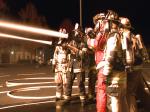CAMDENTON, Mo.– Flames shoot more than 50 feet in the air from a propane truck as a band of firefighters move slowly toward it. The only thing between them and the fire is a wall of water.
In this case, it’s an exercise conducted by University of Missouri Extension’s Fire and Rescue Training Institute (MU FRTI), using a simulator. But with almost almost one in 10 homes in Missouri using propane for heating, it is important for firefighters to prepare for the real thing.
“The University of Missouri Fire and Rescue Training Institute offers this class throughout the state of Missouri to any and all departments that request it,” says Rusty Bradley, an adjunct instructor with MU FRTI. “We try to make it where all firefighters are aware of the dangers that are involved with this LP gas if it’s involved in any type of an incident.”
The class starts with the design of propane tanks, from the 20-pound barbecue grill cylinder all the way up to 18,000-gallon storage tanks. Firefighters learn how they’re built, how their safety features operate and the things that they can expect should one of these devices become involved with a fire.
The fire generated by the simulator is intense, burning at 3,500 degrees Fahrenheit. The first task is to cool the tank. Then firefighters take their hose lines and move the fire so they can safely shut off a valve, turn a knob or pull a handle—whatever it takes to get rid of the fuel that is feeding the fire.
“A lot of people when they see this training think, ‘Well, this is just some training prop,’” says Scott Frandsen, chief of the Mid-County Fire Protection District, headquartered in Camdenton. “Unfortunately, in my career I’ve had the opportunity to do this five times in real life. Each time has been almost the exact duplicate.”
Fred Luckritz, a captain with the Tri-County Fire Protection District in Richland, says this training gives them experience working together and confidence in each other’s skills and abilities.
“You have to put your life in your buddy’s hands.” Luckritz says. “For two guys to hold two streams of water in just the right position for you to reach into a fire to turn off a valve, it’s critical to be able to trust each other.”
Frandsen says a lot of firefighters are volunteers who work other jobs for a living. Bringing these classes to them makes it much easier for a lot more people to get the training.
“I think it’s important to be able to do classes like this because this is a very high-risk type of scenario but it’s a very low-frequency thing,” says Luckritz. “It only happens a couple of times in a firefighter’s career, but you’ve got to know how to handle it to go home safe at the end of the day.”
MU FRTI provides comprehensive continuing professional education to Missouri’s fire service and emergency response personnel. Each year, more than 10,000 fire and emergency service first responders received training from the institute. The institute has a cadre of more than 150 adjunct instructors. For more information, go to www.mufrti.org.
Read more http://extension.missouri.edu/news/DisplayStory.aspx?N=2422





